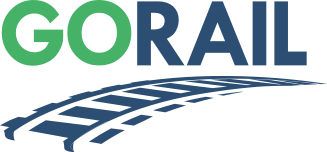Washington, DC — “Engage with the railroads early.” That was the refrain echoed throughout GoRail’s recent On Track for Growth: Leveraging Rail to Drive Economic Development webinar, which brought together experts from state agencies, railroads, and a regional economic development organization to share how local leaders can harness freight rail to spur economic opportunity.
Held on July 23, the webinar convened over 200 municipal, county, and state leaders and economic development professionals for a discussion on positioning communities as rail-ready. The panel emphasized that long-term, transformational investment depends on early collaboration with railroads, strategic site planning, and an understanding of freight’s evolving role in logistics.
The session opened with context from Matthew Dietrich, executive director of the Ohio Rail Development Commission (ORDC), who stressed the need for communities to understand their place in the rail network before embarking on infrastructure plans. “You need to have some situational awareness on how your community fits into the rail network—it isn’t good enough just to have rail running through,” said Dietrich. “The first step… is having the conversations with the railroad so you can level-set expectations.”
That situational awareness includes knowing the commodities moving through your region, the types of railcars used, and the potential land use conflicts that can arise. Dietrich underscored that communities must site industrial parks with multimodal connectivity in mind—from railcars to trucks—while avoiding incompatible uses like residential development near switching yards.
Rob Jones, director of Industrial Development at Norfolk Southern, reinforced this theme, explaining that rail infrastructure requires thoughtful planning well before a project is underway. “Railroad tracks take a lot of space to construct curves,” Jones said. “By bringing the railroad into the discussion as early as possible, we can weigh in on what is realistic… and we can fit the rail throughout the site to most efficiently serve your partners.”
Jones highlighted how Norfolk Southern acts as a free rail consulting partner, providing site planning, conceptual drawings, and even renderings or animations to help visualize how a site can be served by rail. These services, he noted, are invaluable for communities looking to attract rail-served industries. Many railroads offer similar industrial development services, including all Class I railroads.
Rail’s value, Jones added, goes beyond infrastructure—it’s also about resiliency, cost-efficiency, and sustainability. “Rail offers optionality. It offers affordability and it offers sustainability,” he said, noting that railroads operate 24/7 in all weather and are seven times more fuel-efficient than trucking. “We can move one ton of freight with one gallon of diesel fuel almost 500 miles across the rail network.”
His takeaways? Engage early, leverage the railroad’s tools and expertise, and continue to partner on marketing rail-served sites. “We want to market sites along our railroad as rail-served sites that are going to drive jobs and investment in your community,” said Jones.
Gerika Tocker, program administrator at ORDC, detailed how her agency evaluates incentive requests for new and existing businesses, prioritizing projects that promise job creation and sustained rail usage. “Carloads are important to us because [they’re] driving economic development in Ohio,” she said. “We want to make sure that [companies] are serious about doing this project… and that they’ve already spoken to the railroad.” ORDC uses a range of criteria—job commitments, investment levels, rail needs, and site control—before awarding grants or loans.
Offering a regional lens, Katie Meehan, manager of Site Strategies at Team Northeast Ohio, shared how her organization is proactively positioning sites to compete for rail-intensive projects. By analyzing hundreds of past site selection inquiries, Meehan’s team has seen a 20% increase in searches requiring rail over the last five years—and even more identifying it as preferred. “When rail is being requested, it’s typically a make-or-break of the deal,” she said. “Unless you can truly address the company’s concerns around time, risk, and money… you’re typically out of the running before we even start.”
To meet a growing trend of tighter turnarounds for business RFIs (request for information), Team NEO launched the “Developing Opportunities” initiative to help their partners proactively prepare to keep their sites competitive. It includes a toolkit with site evaluation resources, industry-specific sheets, resources on who to engage, and even a glossary of common terms.
Meehan recounted how her team had to pivot quickly when a large Northeast Ohio megasite—originally planned without rail—was an ideal fit for a new mega project opportunity except for it lacking rail service. Early outreach to Norfolk Southern and a local short line helped secure a letter of interest, cost estimates, and a feasible service timeline. “We may have waited to be reactive… but we’re going to be in a much stronger position to continue conversations for the next opportunities.”
The overarching message from the panel: communities that integrate rail into their development strategy from the outset will be the ones that succeed in attracting rail-served industries. Strategic planning, early engagement, and informed partnerships are essential to getting “on track” for growth.


